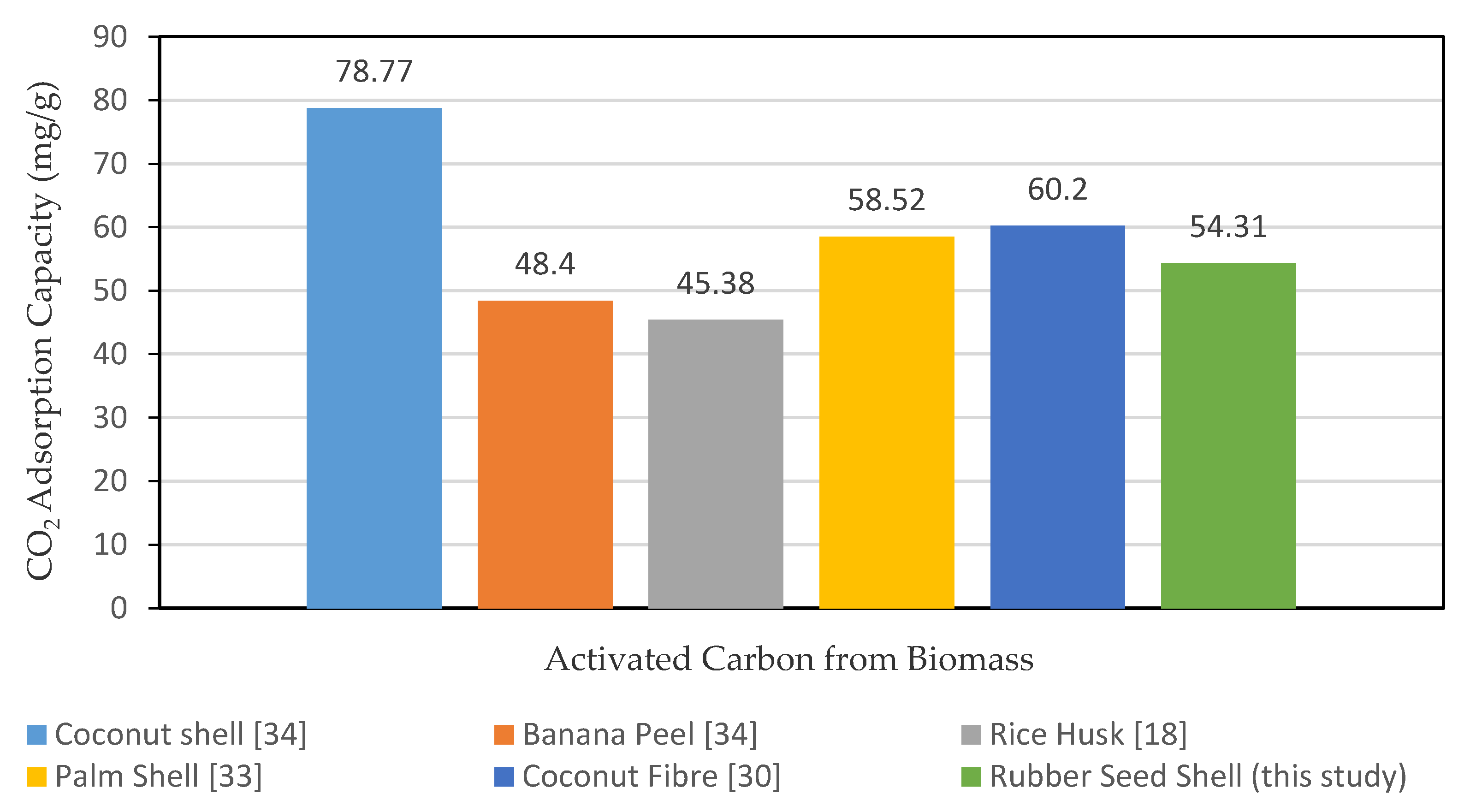Characterization and Modelling Studies of Activated Carbon Produced from Rubber-Seed Shell Using KOH for CO2 Adsorption
Abstract
:1. Introduction
2. Materials and Methods
2.1. Materials and Pre-Treatment
2.2. Activation and Carbonization
2.3. Characterization
2.4. CO2 Adsorption Capacity Analysis
2.5. Kinetic Studies
2.5.1. Pseudo-First Order Kinetic Model
2.5.2. Pseudo-Second Order Kinetic Model
2.5.3. Elovich Kinetic Model
3. Results and Discussion
3.1. Elemental Composition Analysis
3.2. Characterization Study
3.3. Morphology
3.4. Nitrogen Adsorption–Desorption Isotherms Study
3.5. CO2 Adsorption and Isotherm Modeling
3.6. Kinetic Analysis
3.7. Comparison Study with Other Biomass Activated Carbon Materials
4. Conclusions
Author Contributions
Funding
Acknowledgments
Conflicts of Interest
References
- Amira, K.; Mohammad, A. Exploring the Impact of Renewable Energy on Climate Change in the GCC Countries. Int. J. Energy Econ. Policy 2019, 9, 124–130. [Google Scholar]
- Chao, X.; Maria, S. Sustainable Porous Carbon Materials Derived from Wood-Based Biopolymers for CO2 Capture. Nanomaterials 2019, 9, 103. [Google Scholar]
- Olivier, J.G.J.; Janssens-Maenhout, G.; Muntean, M.; Peters, J.A.H.W. Trends in Global CO2 Emissions: 2016 Report; PBL Netherlands Environmental Assessment Agency: The Hague, The Netherlands, 2016; pp. 1–86. [Google Scholar]
- Shahid, S.; Minhans, A.; Che Puan, O. Assessment of greenhouse gas emission reduction measures in transportation sector in Malaysia. J. Teknol. 2014, 70, 1–8. [Google Scholar] [CrossRef]
- Mahdi, F.; Olga, E.; Christian, B. Techno-economic assessment of CO2 direct air capture plants. J. Clean. Prod. 2019, 224, 957–980. [Google Scholar]
- Yuan, W.; Li, Z.; Alexander, O.; Martin, R.D.S. A Review of Post-combustion CO2 Capture Technologies from Coal-fired Power Plants. Energy Procedia 2017, 114, 650–665. [Google Scholar]
- Bryce, D.; Maohong, F.; Armistead, G.R. Amine-Based CO2 Capture Technology Development from the Beginning of 2013-A Review. ACS Appl. Mater. Interfaces 2015, 7, 2137–2148. [Google Scholar]
- Singh, V.K.; Kumar, E.A. Measurement and analysis of adsorption isotherms of CO2 on activated carbon. Appl. Therm. Eng. 2016, 97, 77–86. [Google Scholar] [CrossRef]
- Srinivas, B.N.; Kishore, P.; Rao, K.S.; Kumar, T.A. Preparation of surface modified activated carbons from rice husk and CO2 adsorption studies. IOSR J. Appl. Chem. 2017, 10, 54–60. [Google Scholar]
- Boonpoke, A.; Chiarakon, S.; Laosiripojana, N.; Towprayoon, S.; Chidthaisong, A. Synthesis of activated carbon and MCM-41 from bagasse and rice husk and their carbon dioxide adsorption capacity. J. Sustain. Energy Environ. 2011, 2, 77–81. [Google Scholar]
- Ademiluyi, F.T.; David-West, E.O. Effect of chemical activation on adsorption of heavy metals using activated carbons from waste materials. Int. Sch. Res. Netw. 2012. [Google Scholar] [CrossRef]
- Borhan, A.; Hoong, P.K.; Taha, M.F. Biosorption of heavy metal ions, oil and grease from industrial waste water by banana peel. Appl. Mech. Mater. 2014, 625, 749–752. [Google Scholar] [CrossRef]
- Jahagindar, A.A.; Ahmed, M.N.Z.; Devi, D.V. Adsorption of chromium on activated carbon prepared from coconut shell. Int. J. Eng. Res. Appl. 2012, 2, 364–370. [Google Scholar]
- El-Sadaawy, M.; Abdelwahab, O. Adsorptive removal of nickel from aqueous solutions by activated carbons from doum seed coat. Alex. Eng. J. 2014, 53, 399–408. [Google Scholar] [CrossRef]
- Zabihi, M.; Haghighi, A.A.; Ahmadpour, A. Studies on adsorption of mercury from aqueous solution on activated carbons prepared from walnut shell. J. Hazard. Mater. 2010, 174, 251–256. [Google Scholar] [CrossRef]
- Yahya, M.; Al-Qodah, Z.; Ngah, C. Agriculture bio-waste materials as potential sustainable precursors used for activated carbon production: A review. Renew. Sustain. Energy Rev. 2015, 46, 218–235. [Google Scholar] [CrossRef]
- Borhan, A.; Taha, M.F.; Hamzah, A.A. Characterization of activated carbon from wood sawdust via chemical activation using potassium hydroxide. Adv. Mater. Res. 2014, 832, 132–137. [Google Scholar] [CrossRef]
- Rashidi, N.A.; Yusup, S.; Borhan, A. Isotherm and Thermodynamic Analysis of Carbon Dioxide on Activated. Procedia Eng. 2016, 148, 630–637. [Google Scholar] [CrossRef]
- Al-Marri, M.J.; Al-Saad, M.K.; Saad, M.A.; Cortes, D.J.; Khader, M.M. Thermodynamics of CO2 adsorption on polyethyleneimine mesoporous silica and activated carbon. J. Phys. Chem. Biophys. 2017, 1, 1–5. [Google Scholar]
- Jhonatan, R.G.R.; Juan Carlos, M.P.; Liliana, G.G. Kinetic and Equilibrium Study of the Adsorption of CO2 in Ultramicropores of Resorcinol-Formaldehyde Aerogels Obtained in Acidic and Basic Medium. J. Carbon Res. 2018, 4, 1–19. [Google Scholar]
- Eka, H.D.; Tajul, A.Y.; Wan, N.W.A. Potential use of Malaysian rubber (Hevea brasiliensis) seed as food, feed and biofuel. Int. Food Res. J. 2010, 17, 527–534. [Google Scholar]
- Borhan, A.; Hamidi, M.N.R. Modification of Rubber-Seed Shell Activated Carbon using Chitosan for Removal of Cu2+ and Pb2+ from Aqueous Solution. In Proceedings of the International Symposium on Green and Sustainable Technology (ISGST 2019), Perak, Malaysia, 23–26 April 2019; Volume 2157, p. 020024. [Google Scholar]
- Cao, Q.; Xie, K.C.; Liv, Y.K.; Bao, W.R. Process effects of activated carbon with large specific area from corncob. Bioresour. Technol. 2012, 97, 110–115. [Google Scholar] [CrossRef] [PubMed]
- Ogungbenro, A.E.; Quang, D.V.; Al-Ali, K.; Abu-Zahra, M.R.M. Activated carbon from date seeds for CO2 capture applications. Energy Procedia 2017, 114, 2313–2321. [Google Scholar] [CrossRef]
- Chao, G.; Dandan, L.; Shaopeng, C.; Jie, G.; Jianjun, L. Highly Selective CO2 Capture on Waste Polyurethane Foam-Based Activated Carbon. Processes 2019, 7, 1–15. [Google Scholar]
- Mays, T.J. A new classification of pore sizes. Stud. Surf. Sci. Catal. 2007, 160, 57–62. [Google Scholar]
- Esteves, I.A.A.C.; Lopes, M.S.S.; Nunes, P.M.C.; Mota, J.B.P. Adsorption of natural gas and biogas components on activated carbon. Sep. Purif. Technol. 2008, 62, 281–296. [Google Scholar] [CrossRef]
- Hauchhum, L.; Mahanta, P. Kinetic, thermodynamics and regeneration studies for CO2 adsorption onto activated carbon. Int. J. Adv. Mech. Eng. 2014, 4, 27–32. [Google Scholar]
- Simon, J.C.; Bushra, A.D.; Nannan, S.; Cheng-gong, S.; Colin, E.S.; Kaixi, L.S.; Joseph, W. Carbon Dioxide Separation from Nitrogen/Hydrogen Mixtures over Activated Carbon Beads: Adsorption Isotherms and Breakthrough Studies. Energy Fuels 2015, 29, 3796–3807. [Google Scholar]
- Perez, N.; Sanchez, M.; Rincon, G.; Delgado, L. Study of the behaviour of metal adsorption in acid solutions on lignin using a comparison of different adsorption isotherms. Lat. Am. Appl. Res. 2015, 37, 157–162. [Google Scholar]
- Li, J.; Hitch, M. Carbon dioxide sorption isotherm study on pristine and acid-treated olive and its application in the vacuum swing adsorption process. Miner 2015, 5, 259–275. [Google Scholar] [CrossRef]
- Sadaf, S.; Bhatti, H.N. Evaluation of peanut husk as a novel, low cost biosorbent for the removal of Indosol Orange RSN dye from aqueous solutions: Batch and fixed bed studies. Clean Technol. Environ. Policy 2014, 16, 527–544. [Google Scholar] [CrossRef]
- Jia, Z.; Li, Z.; Ni, T.; Li, S. Adsorption of low-cost absorption materials based on biomass (Cortaderia selloana flower spikes) for dye removal: Kinetics, isotherms and thermodynamic studies. J. Mol. Liq. 2017, 229, 285–292. [Google Scholar] [CrossRef]
- Rashidi, N.A.; Yusup, S.; Hameed, B.H. Kinetic studies on CO2 capture using lignocellulosic based activated carbon. Energy 2013, 61, 440–446. [Google Scholar] [CrossRef]
- Balsamo, M.; Budinova, T.; Erto, A.; Lancia, A.; Petrova, B.; Petrov, N.; Tsyntsarski, B. CO2 adsorption onto synthetic activated carbon: Kinetic, thermodynamic and regeneration studies. Sep. Purif. Technol. 2013, 116, 214–221. [Google Scholar] [CrossRef]
- Shieu, A.; Hu, S.C.; Chang, S.M.; Ko, T.Y.; Hsieh, A.; Chan, A. Adsorption kinetics and breakthrough of carbon dioxide for the chemical modified activated carbon filter used in the building. Sustanability 2017, 9, 1533. [Google Scholar] [CrossRef]
- Khalili, S.; Khoshandam, B.; Jahanshahi, M. Optimization of production conditions for synthesis of chemically activated carbon produced from pine cone using response surface methadology for CO2 adsorption. RSC Adv. 2015, 5, 94115–94129. [Google Scholar] [CrossRef]
- Ismat, H.A.; Mohammed, K.A.; Mohammad, I.K.; Mohd, D.; Majed, M.A. Exploring Adsorption Process of Lead (II) and Chromium (VI) Ions from Aqueous Solutions on Acid Activated Carbon Prepared from Juniperus procera Leaves. Processes 2019, 7, 1–14. [Google Scholar]
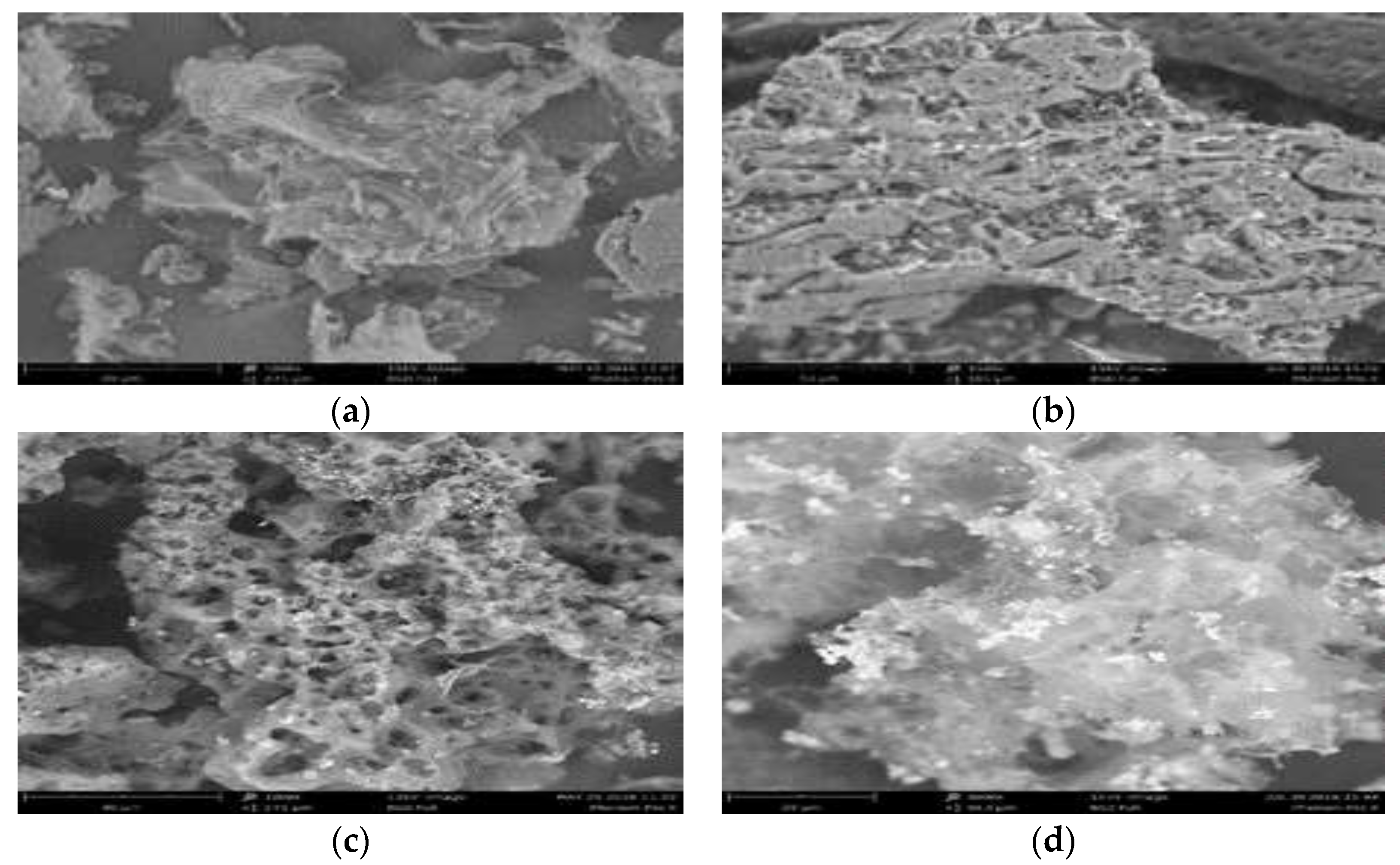
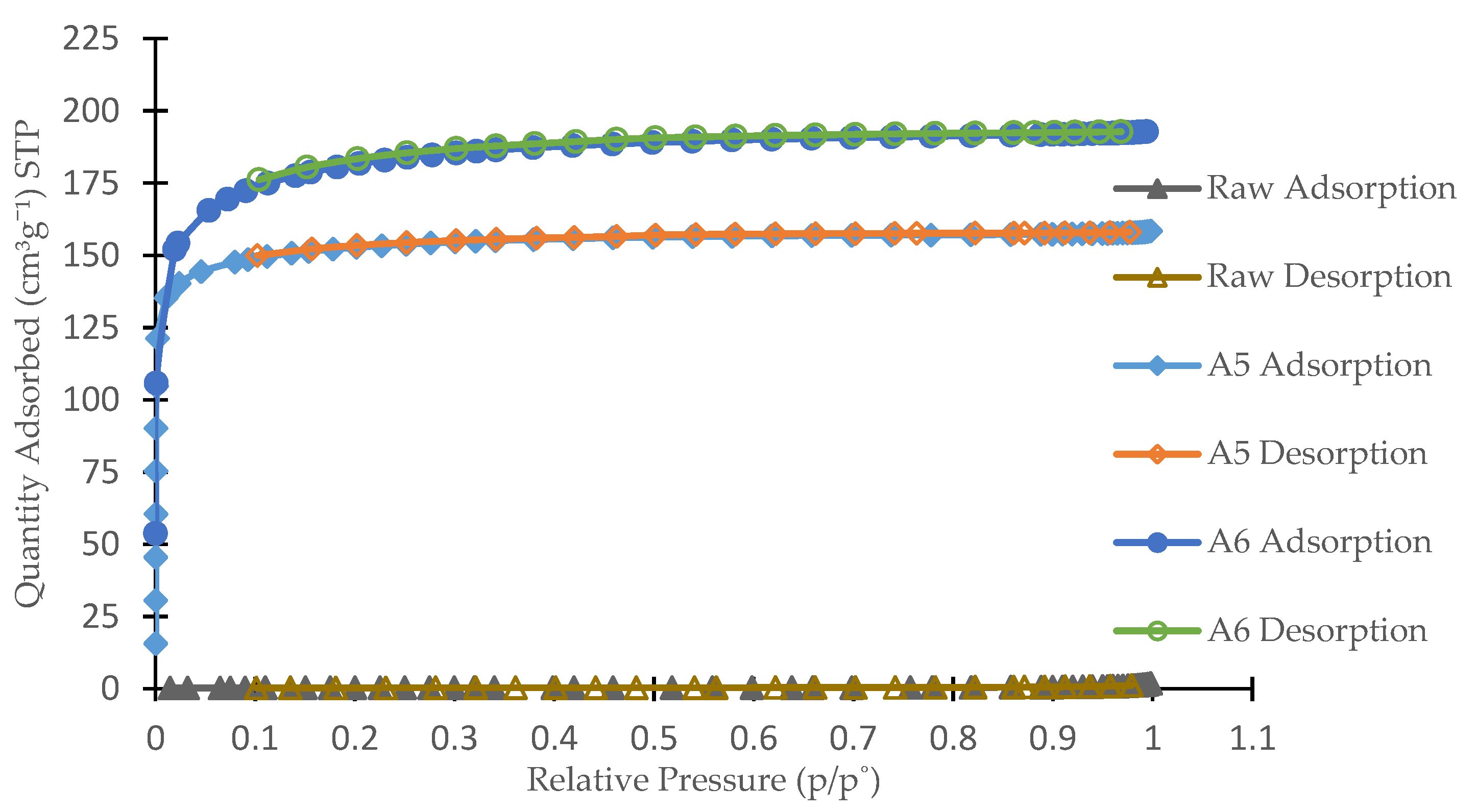
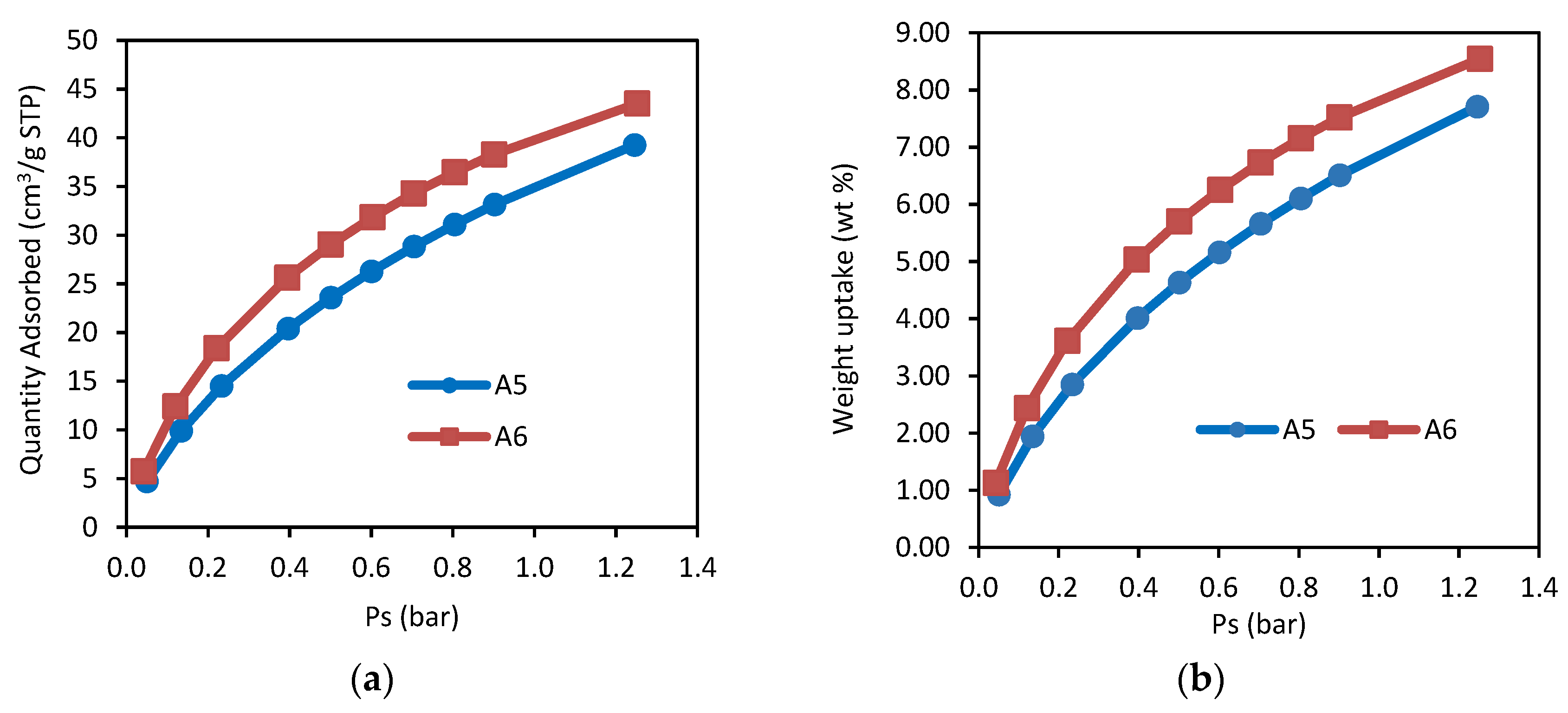
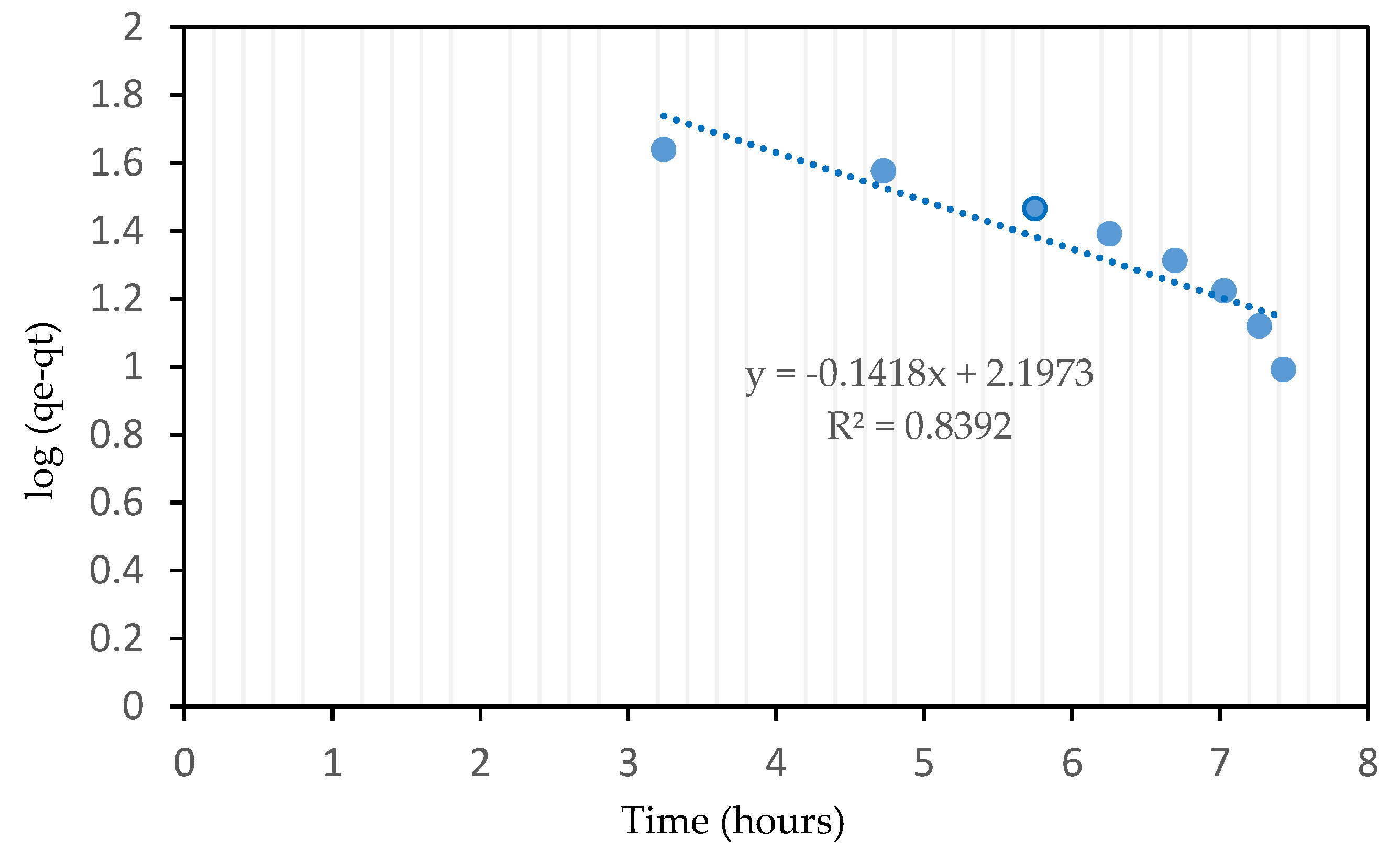
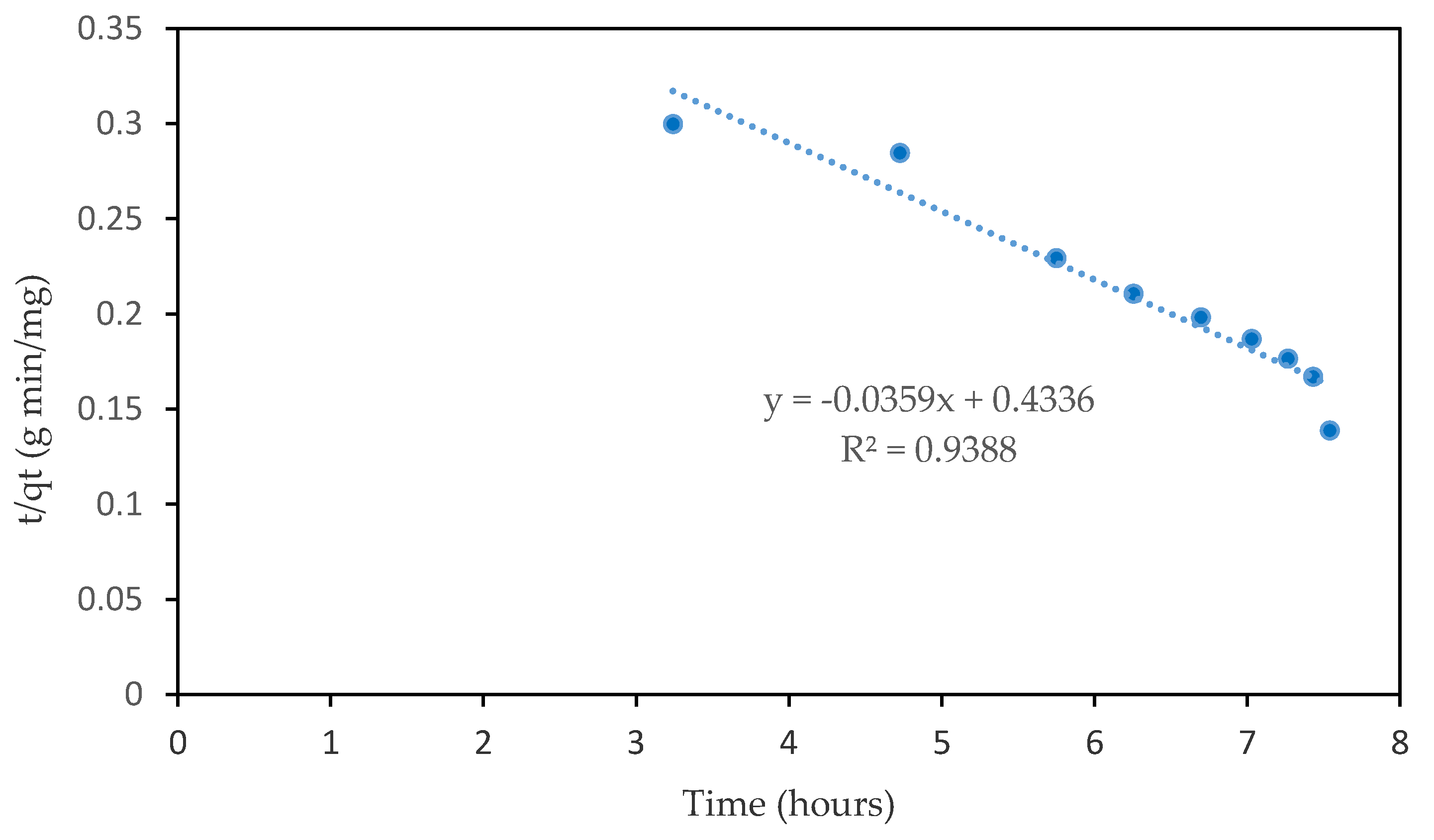
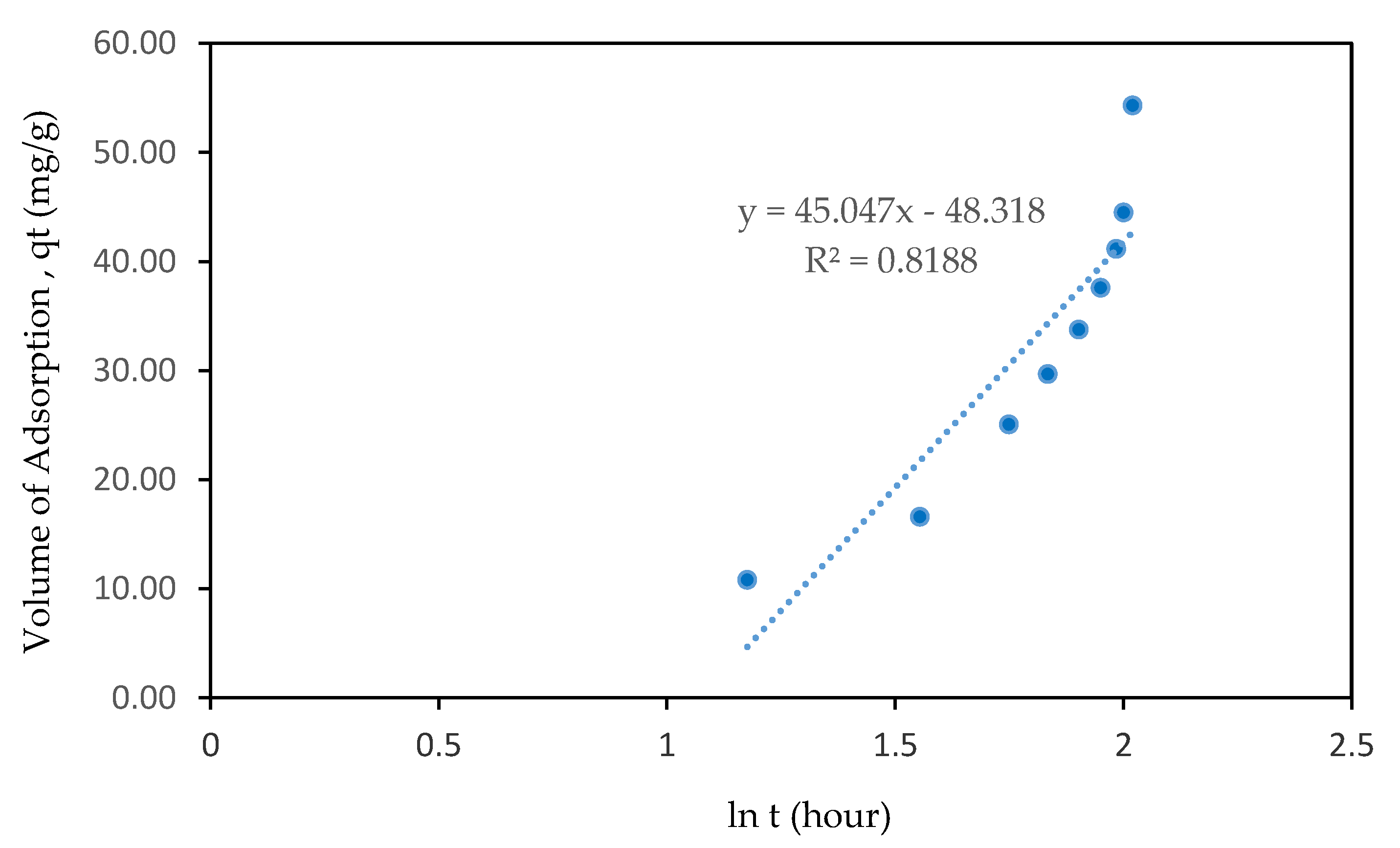
| Isotherm | Non-Linear Equation | Linear Equation |
|---|---|---|
| Langmuir | ||
| Freundlich | ||
| Temkin |
| Elements | Before Carbonization (RAW) | After Carbonization (A6) | ||
|---|---|---|---|---|
| Weight % | Atomic % | Weight % | Atomic % | |
| Carbon | 50.8 | 59.2 | 56.6 | 65.0 |
| Oxygen | 44.4 | 39.4 | 27.3 | 21.7 |
| Potassium | - | - | 12.5 | 8.3 |
| Calcium | 4.8 | 1.4 | 3.6 | 5.0 |
| Total | 100 | 100 | 100 | 100 |
| Sample | IR | Act. Temp (°C) | Act. Time (min) | Specific Surface Area, SBET (m2/g) | Total Pore Volume, VT (cm3/g) | Average Pore Diameter, D (nm) | Percentage Micropores (%) |
|---|---|---|---|---|---|---|---|
| Raw | - | - | - | 1.11 | 0.007 | 1.26 | 19.82 |
| A1 | 1:1 | 400 | 60 | 203.81 | 0.113 | 1.81 | 78.71 |
| A2 | 1:1 | 500 | 60 | 481.19 | 0.191 | 2.06 | 78.90 |
| A3 | 1:2 | 500 | 60 | 571.86 | 0.203 | 2.17 | 85.29 |
| A4 | 1:3 | 500 | 60 | 492.12 | 0.182 | 2.26 | 53.73 |
| A5 | 1:2 | 600 | 120 | 826.31 | 0.376 | 3.21 | 34.24 |
| A6 | 1:2 | 700 | 120 | 1129.60 | 0.412 | 3.46 | 31.67 |
| A7 | 1:2 | 700 | 180 | 618.13 | 0.406 | 3.37 | 28.34 |
| A8 | 1:2 | 800 | 120 | 731.06 | 0.301 | 3.21 | 24.27 |
| A9 | 1:2 | 900 | 120 | 701.45 | 0.235 | 3.72 | 15.13 |
| Sample | Langmuir | Freundlich | Temkin | |||||||
|---|---|---|---|---|---|---|---|---|---|---|
| qm | kL | R2 | kF | n | R2 | kT | B | bT | R2 | |
| A6 | 57.47126 | 2.202532 | 0.9901 | 42.07266 | 1.67364 | 0.9902 | 28.81605 | 11.365 | 218.1099 | 0.9708 |
| A5 | 57.80347 | 1.478632 | 0.9772 | 36.19095 | 1.515611 | 0.9962 | 21.37372 | 10.73 | 231.0176 | 0.9487 |
| Kinetic Model | Parameter | Temperature (25 °C) |
|---|---|---|
| Pseudo-first order model | qe (mg/g) | 54.31 |
| k1 (1/min) | 0.221 | |
| R2 | 0.839 | |
| Pseudo-second order model | qe (mg/g) | 61.15 |
| k2 (g/mg min) | 7.82 × 10−4 | |
| h (mg/g min) | 2.306 | |
| R2 | 0.939 | |
| Elovich model | β (g/mg) | 0.022 |
| α (mg/g min) | 2.92 | |
| R2 | 0.8188 |
© 2019 by the authors. Licensee MDPI, Basel, Switzerland. This article is an open access article distributed under the terms and conditions of the Creative Commons Attribution (CC BY) license (http://creativecommons.org/licenses/by/4.0/).
Share and Cite
Borhan, A.; Yusup, S.; Lim, J.W.; Show, P.L. Characterization and Modelling Studies of Activated Carbon Produced from Rubber-Seed Shell Using KOH for CO2 Adsorption. Processes 2019, 7, 855. https://doi.org/10.3390/pr7110855
Borhan A, Yusup S, Lim JW, Show PL. Characterization and Modelling Studies of Activated Carbon Produced from Rubber-Seed Shell Using KOH for CO2 Adsorption. Processes. 2019; 7(11):855. https://doi.org/10.3390/pr7110855
Chicago/Turabian StyleBorhan, Azry, Suzana Yusup, Jun Wei Lim, and Pau Loke Show. 2019. "Characterization and Modelling Studies of Activated Carbon Produced from Rubber-Seed Shell Using KOH for CO2 Adsorption" Processes 7, no. 11: 855. https://doi.org/10.3390/pr7110855
APA StyleBorhan, A., Yusup, S., Lim, J. W., & Show, P. L. (2019). Characterization and Modelling Studies of Activated Carbon Produced from Rubber-Seed Shell Using KOH for CO2 Adsorption. Processes, 7(11), 855. https://doi.org/10.3390/pr7110855







